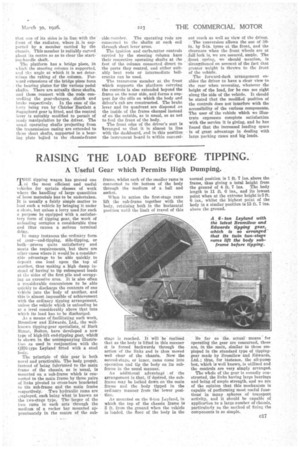RAISING THE LOAD BEFORE TIPPING.
Page 15

If you've noticed an error in this article please click here to report it so we can fix it.
A Useful Gear which Permits High Dumping.
TI-IE tipping wagon has proved one of the most efficient and useful vehicles for certain classes of work where the handling of large quantities of loose materials has to be undertaken. It is usually a fairly simple matter to load such a vehicle by bringing it under a chute, but unless a lorry used for such a purpose be equipped with a satisfactory form of tipping gear, the work of unloading occupies a considerable time and thus causes a serious terminal delay.
In many instances the ordinary form of gear—end-tipping, side-tipping, or both—proves quite satisfactory and meets the requirements, but there are other cases where it would be a considerable advantage to be able quickly to deposit one load upon the top of another, thus making a high dump instead of having' to tip subsequent loads at the sides of the first pile and occupying an excessive area. It is also often a considerable convenience to be able quickly to discharge the contents of one vehicle into the body of another, and this is almost impossible of achievement with the ordinary tipping arrangement, unless the vehicle which is unloading be at a level considerably above that into which its load has to be discharged.
As a means of facilitating such work, Bromilow and Edwards, Ltd., the wellknown tipping-gear specialists, of Bark Street, Bolton, have developed a new type of high-lift end-tipping gear, which is shown in the accompanying illustration as used in conjunction with the QH6-type Leyland fitted with a steel body.
The principle of this gear is both novel and practicable. The body propel., instead of being fulcrnmed to the main frame of the chassis, as is usual, is mounted on a sub-frame which is connected to the main frame by three pairs of links pivoted to cross-bars bracketed to the sub-frame and the main frame respectively. Two hydraulic rams are k.mployed, each being what is known as the two-stage type. The larger of the two rams in each acts through the medium of a rocker bar mounted approximately in the centre of the sub
frame, whilst each of the smaller rams is connected to the bottom of the body through the medium of a ball and socket.
When in action the first-stage rams lift the sub-frame together with the body, retaining both in the horizontal position until the limit of travel of this stage is reached. It will be realized that as the body is lifted in this manner it is forced backwards through the action of the links and is thus moved well clear of the chassis. Now the second-stage, or inner, rams come into operation and tip the body on its subframe in the usual manner.
An additional advantage of the arrangement is that, if desired, the subframe may be locked down on the main frame and the body tipped in the ordinary manner from the lower position.
As mounted on the 6-ton Leyland, in which the top of the chassis frame is 3 ft. from the ground when the vehicle is loaded, the floor of the body in the normal position is 1 ft. 7 ins, above the frame, thus giving a total height from the ground of 4 ft. 7 ins. The body length is 11 ft. 6 ins-, and its lowest point when at the extreme height is 5 ft. 6 ins., whilst the highest point of the body in a similar position is 15 ft. 7 ins. above the ground.
o far as the actual means for operating the gear are concerned, these are, in the main, similar to those employed in the standard type of tippinggear made by Dromilow and Edwards, Ltd.; thus, for instance, the oil-pump box, which is well known, is utilized and the controls are very simply arranged.
The whole of the gear is soundly constructed, the links having large bearings and being of ample strength, and we are of the opinion that this mechanism is capable of performing most useful funetions in many spheres of transport activity, and it should be capable of application to a large number of chassis, particularly as the method of fixing the components is so simple.


































